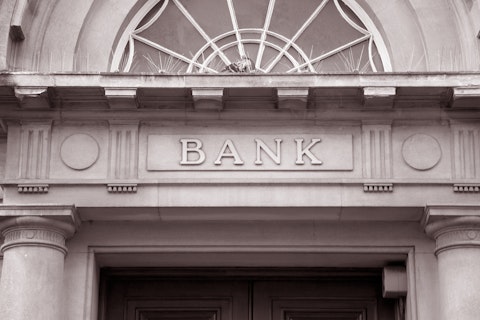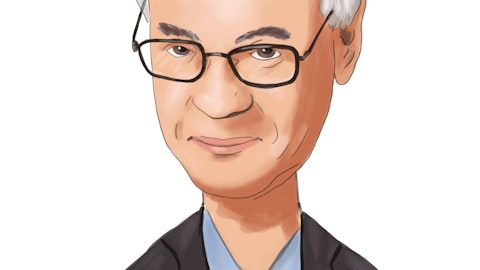CrossFirst Bankshares, Inc. (NASDAQ:CFB) Q3 2023 Earnings Call Transcript October 17, 2023
Operator: Good morning, and welcome to the CrossFirst Bankshares Inc., Q3 2023 Earnings Conference Call. All participants will be in listen-only mode. [Operator Instructions] After today’s presentation, there will be an opportunity to ask questions. [Operator Instructions] Please note, this event is being recorded. I would now like to turn the conference over to Mike Daley, Chief Accounting Officer and Head of Investor Relations. Please go ahead.
Mike Daley: Good morning, and welcome to CrossFirst Bankshares’ third quarter 2023 earnings conference call. Before we begin, please be aware this call will include forward-looking statements, including statements about our business plans, expansion and growth opportunities, expense control initiatives, sources of liquidity, capital allocation strategies, and our future financial performance. These comments are based on our current expectations and assumptions and are subject to risks and uncertainties that could cause actual results to differ materially from these statements. Our forward-looking statements are as of the date of this call and we do not assume any obligation to update or revise them except as required by law.
Statements made on this call should be considered together with the risk factors identified in today’s earnings release and our other filings with the SEC. We may also refer to adjusted or non-GAAP financial measures. A reconciliation of non-GAAP financial measures to GAAP financial measures can be found in our earnings release. These non-GAAP financial measures are not meant to be a substitute for or superior to financial measures prepared in accordance with GAAP. Our presentation will include prepared remarks from Mike Maddox, President and CEO of CrossFirst Bankshares; Randy Rapp, President of CrossFirst Bank; and Ben Clouse, CFO of CrossFirst Bankshares. At the conclusion of our prepared remarks, our operator, Anthony, will facilitate a Q&A session.
At this time, I would like to turn the call over to Mike, who will begin on Slide 5 of the presentation available on our website and filed with our earnings release. Mike?
Mike Maddox: Thank you, and good morning, everyone. I’m very proud of this quarter and the great job that our team is doing. We are seeing the benefits of the investments we have made over the last 24 months. We continue to execute on our strategic plans this quarter with growth in operating revenue, core deposits, and earnings despite a difficult macro environment for banking. We delivered 7% growth in adjusted earnings this quarter with adjusted net income of $18.6 million, or $0.37 per share. We remain focused on improving profitability by scaling our franchise in our high growth dynamic markets and verticals, optimizing our expense base and driving efficiency, all while remaining diligent on credit quality. Pressure on our margin has slowed due to some normalization of pricing for deposits.
We also continue to benefit from our highly variable loan portfolio. Our focus as a company is on earnings and profitability growth and less so on balance sheet growth, as we drive improved efficiency and operating leverage. Competition for deposits continues to be strong, despite that, however, our funding composition continues to improve as core deposits increased while wholesale borrowings declined and our loan-to-deposit ratio improved this past quarter. As expected, our loan portfolio grew modestly this quarter and we continue to see nice balance in our loan mix. Additionally, I’m pleased to share that our SBA lending platform continues to gain traction across our markets and is accelerating our non-interest income growth. Credit quality continues to be a primary focus, especially in the face of the number — excuse me, of challenging external factors.
Our overall credit quality remains at manageable levels that are well within acceptable norms. Randy will cover credit in more detail in a moment, but let me just say that I remain confident in our high quality credit standards, our well diversified portfolio, and more importantly our relationship based client approach. During this past quarter, we completed our Tucson acquisition, which complements our existing Arizona franchise and provides additional liquidity and lower cost deposits. We were excited to welcome our new shareholders, clients, and team members and look forward to supporting the needs of the Tucson community. We expect to have our Tucson clients fully onboarded to our systems by mid-November. Looking ahead, we are in a unique position with the opportunity to increase profitability through multiple levers, scaling our existing investments, optimizing expenses, and maintaining a focus on credit quality.
We have the opportunity to increase profitability by gaining density in our dynamic high growth metro markets and verticals. In addition, we intend to continue to prudently manage expenses including an ongoing focus on optimizing operations, leveraging key technology, and infrastructure investments. Finally, maintaining solid credit quality is at the center of everything we do. Our team is focused on these priorities, which we believe position CrossFirst for the future while enhancing our franchise value. And now, I’d like to turn the call over to our President of CrossFirst Bank, Randy Rapp.
Randy Rapp: Thanks, Mike, and good morning, everyone. In Q3, we continued to intentionally moderate the pace of loan growth. We remained highly focused on deposit generation and closely monitored our portfolio metrics. In Q3, we reported total loan growth of $149 million, resulting in a growth rate of 2.6% for the quarter or 10% on an annualized basis. The increase was primary — primarily attributable to a $106 million in loans from the Tucson acquisition, which are largely USDA and SBA guaranteed commercial real estate and C&I credits. Legacy markets and lines grew approximately $43 million, led by a slight increase in CRE exposure, primarily due to fundings on existing relationships. We continue to focus on increasing loan yields and the average loan yield on new production in the quarter was a strong 8.54%.
Average C&I line utilization for the quarter was 47%, which is slightly above the prior quarter, and portfolio churn decreased slightly and is now below the historical average level. We expect portfolio churn to decrease slightly over the next several quarters. Our loan portfolio continues to remain balanced with 43% in commercial real estate and 44% in C&I and owner occupied real estate. Energy exposure is now $214 million or 4% of the total portfolio. On Slide 6, you can see, there remains good diversity within each of these portfolios with the highest CRE property type industrial accounting for 19% of total CRE exposure and the largest industry segment in C&I being manufacturing at 10% of C&I exposure. Total office exposure is now $294 million, down slightly from $312 million at the end of Q2, and is 5% of total loans.
The average office loan size remained $7 million and the largest is $25 million. The average loan-to-value is 61% and the majority of the portfolio is suburban Class A and Class B office. As we have previously stated, we will follow our strongest sponsors to other markets, but the majority of this exposure is in our footprint centered in North Texas, Kansas City, and Colorado. Moving to credit highlights on Slide 7, for Q3, we reported an increase in non-performing assets to $36.1 million, resulting in a non-performing asset to total asset ratio of 50 basis points. The increase was primarily due to two C&I credits and one CRE credit moving to non-performing. I’m pleased to report that one of the C&I credits with a $13.6 million balance that was over 90 days past due at quarter end, has raised fresh equity and plans to bring the credit current this week.
This action will lower our NPAs back to $22.5 million or 31 basis points of total assets. The remaining non-performing loans are primarily C&I with one fully secured commercial real estate transaction. This remaining NPA ratio of 31 basis points is in line with the same period in 2022 and our ORE balance remains at zero. Classified assets to capital plus combined reserves ended Q3 at 14%, which is up from 9.6% the end of Q2, but remains at a low level. The increase in classified assets was due to downgrades of several C&I and CRE credits. $21 million of the increase is well secured by current real estate valuations and $5 million has USDA or SBA guarantees. We do not expect any material loss from these loans and we are proactively managing each relationship.
In addition, $5 million of the increase in classifieds was due to acquired loans, which were mark-to-market in the quarter. For the quarter, we reported net charge-offs of $1.3 million, resulting in a charge-off rate of 9 basis points on an annualized basis, and 5 basis points on a trailing 12-month basis. At quarter end, we reported an allowance for credit loss to total loan ratio of 1.2%, which is up from 1.17% at the end of Q2. The combined allowance for credit loss and reserve for unfunded commitments totaled 1.31%. For the quarter, we reported provision expense of $3.3 million, resulting in a provision to charge-off rate of 254%. Provision was higher than Q2 due to Day 1 CECL reserves for the acquired Tucson loans and changes in credit metrics during the quarter.
With a total ACL of $72 million, our current ACL to non-performing loan ratio is nearly 200%. We remain highly focused on maintaining good credit metrics moving forward. Turning to Slide 8. Deposits increased 3.8% to $6.3 billion, up $232 million from the previous quarter. Non-interest bearing deposits increased during the quarter to $1 billion and now represents 16% of total deposits, up from 15% at the end of the second quarter. Ben will cover additional deposit portfolio statistics in his remarks. We continue to focus heavily on deposit generation, expanding fee income with treasury management and credit card products, improving loan yields in the portfolio with new originations and as existing facilities mature, and monitoring the portfolio for performance issues.
We remain confident in our proven sponsors and underwriting standards, which include significant equity contributions, but we could continue to see some negative grade movement in the short term. We expect our loan growth rate to continue to be at a moderate level in the last quarter of 2023, but we continue to actively call on clients to generate a healthy pipeline of new transactions heading into 2024. I will now turn the call over to Ben to cover the financial results in more detail. Ben?
Ben Clouse: Thanks, Randy, and good morning, everyone. GAAP net income this quarter was $16.9 million or $0.34 per share. The third quarter included acquisition-related charges of $1.3 million and as Randy said, a Day 1 CECL provision of $0.9 million, resulting in adjusted net income of $18.6 million or $0.37 per share. Both GAAP and adjusted net income improved from the prior quarter with slowing margin pressure yielding increased net interest income, an increase in non-interest income, and lower non-interest expenses. These gains were partially offset by a higher provision. Quarterly adjusted return on average assets was 1.04% and adjusted return on average equity was 11.3%. We saw a modest balance sheet growth, primarily from the acquisition and continued our progress toward driving higher profitability through expense management in the quarter.
Net interest income on a fully tax equivalent basis expanded slightly by $0.5 million from the second quarter due to the benefit of higher average earning assets, higher loan yields, and one additional day, which were partially offset by higher cost of funds. Average earning assets increased $183 million compared to the prior quarter with most of the net increase from the Tucson acquisition. The yield on loans increased 9 basis points due to repricing as well as higher yields on new loans and was negatively impacted 7 basis points due to the net impact of non-accrual loans as we are proactively addressing any signs of weakness in the portfolio. Turning to Page 9. Our total cost of deposits was 3.59% for the quarter against loan yields of 6.96%.
Our total non-maturity deposit beta against the entire rate cycle through the third quarter was 57, in line with our expectations and we have slowed the growth in our cost of funds. Our deposit base remained consistent with the prior quarter in terms of diversification and composition. We were very pleased to see that deposit growth beyond the acquisition impact, as well as growth in non-interest bearing deposits, which allowed us to decrease wholesale funding and FHLB borrowings during the quarter. Our effective uninsured deposits percentage and our deposit concentration across the top 25 clients remained consistent in this quarter. Fully tax equivalent net interest margin narrowed 8 basis points compared to the prior quarter to 3.19%. Our core NIM adjusting out noise from accrual impacts has remained stable in a range of 3.21% to 3.23% since May.
Our balance sheet is only slightly sensitive through a potential additional 25 basis point rate move yet this year and we expect margin to be in a range of 3.20% to 3.25% in Q4. With continued lower anticipated loan growth, we don’t expect as great of a need to add higher cost deposits going forward. While we acknowledge the competition for deposits will persist, we believe we are near the peak of deposit pricing, allowing us to continue to defend our NIM as we move forward from here. Non-interest income was $6 million for the quarter, increasing 3% from the second quarter. The primary drivers were growth of treasury and credit card revenues. These improvements were partially offset by lower SBA loan sales after some pent-up demand in second quarter as we transitioned back to an originate and sell model.
Moving to Slide 10. Excluding the acquisition related severance and core deposit intangible expenses from both Q3 and Q2, non-interest expense decreased $0.9 million compared to the second quarter of ’23 due to lower compensation and discretionary expenses. We advanced our efforts to drive additional efficiencies and gain operating leverage in the quarter and we will continue our focus on cost control with adjusted efficiency improving 2% to 55% this quarter. Our headcount remained flat in the quarter despite the Tucson acquisition and we anticipate it to remain stable for the rest of the year. Our tax rate was 21% for the quarter and we expect the tax rate to remain in a range of 20% to 22%. Tangible book value per share was 3% lower compared to the prior quarter due to the unrealized loss on available for sale securities.
On a year-to-date basis, excluding the impacts of the unrealized losses, we have grown tangible book value per share by 7%. As of quarter end, we are well capitalized under all capital ratios. We continue to advance our goal of building capital this quarter as we saw moderating asset growth, strong earnings, and a continued decline in unfunded commitments. We are continuing to work toward our goals of 11% total risk based capital and 10% CET1 ratios by year end and intend to continue to focus on building capital from here. On Slide 11, our liquidity remains strong, consistent with the prior quarter at 34% of assets. We have significant liquidity of approximately $2.4 billion from on and off-balance sheet sources. In addition to our cash on the balance sheet, our 100% AFS investment portfolio includes $332 million that can be pledged to the FHLB and we have an additional $46 million of securities we could sell today at a net gain.
We also have multiple sources of additional off-balance sheet liquidity, including FHLB, Federal Reserve, Fed funds, and other wholesale funding sources, totaling approximately $1.5 billion. We have continued to increase the liquidity in our investment portfolio with an ongoing moderate shift in the ratio of munis. We are evaluating all of our options to improve the yields on our earning assets including potential restructuring scenarios. As Mike mentioned, we closed the Tucson acquisition in the quarter, resulting in $4.5 million in core deposit intangibles and $5.2 million in day one loan marks, both consistent with our diligence modeling. We are on track for a fourth quarter system integration and full realization of our expected cost savings.
This acquisition was immediately accretive with very modest dilution and a short earn back of less than two years. In summary for the quarter, we continued to grow profitability, held NIM constant, and expanded our client deposits in a very competitive environment. Operator, we’re now ready to begin the question-and-answer portion of the call.
See also 23 Best Outlet Malls in America For Great Deals and 20 Most Innovative States in the US.
Q&A Session
Follow Crossfirst Bankshares Inc. (NASDAQ:CFB)
Follow Crossfirst Bankshares Inc. (NASDAQ:CFB)
Receive real-time insider trading and news alerts
Operator: We will now begin the question-and-answer session. [Operator Instructions] Our first question will come from Brady Gailey with KBW. You may now go ahead.
Brady Gailey: Hey. Thank you. Good morning, guys.
Mike Maddox: Good morning, Brady.
Brady Gailey: So your net interest margin was 3.19% in the third quarter, if you look at 4Q, you’re saying it’s going to be 3.20% to 3.25%, so are you basically calling a bottom on the margin here, with it going up next quarter and then, any thoughts on how you think the margin could trend next year in ’24?
Ben Clouse: Hey. Good morning, Brady. It’s Ben. We do think we’re at the bottom just especially given the stability we have seen, as I mentioned in my remarks, Q2 had a pickup of 3 basis points or 4 basis points from accrual changes, Q3 had the headwind of 3 basis points or 4 basis points from accrual changes, but we’ve really seen very good stability in the margin and expect that through year end. We’re right in the midst of planning for 2024, but thinking ahead a little bit, I think we continue to expect to see that stability and some expansion as our loan portfolio continues to reindex.
Brady Gailey: All right. And then, we’ve heard you guys talk about the two capital targets that you’d like to hit at the end of this year, which it looks like you’ll be able to do. Will capital continue to build even beyond those two thresholds of the 11% and the 10%, I’m just — I’m trying to indirectly figure out if the buyback is back on the table next year just given the stock is still well below tangible book value.
Mike Maddox: Yeah. Brady, I think those were our year end targets, we expect to hit those. We will continue to build some capital, but I think we will also look to be opportunistic if our stock continues to trade where it’s at and look at returning some capital to shareholders.
Brady Gailey: Okay. All right. Great. Thanks, guys.
Operator: Our next question will come from Michael Rose with Raymond James. You may now go ahead.
Michael Rose: Hey. Good morning, guys. Thanks for taking my questions. Just wanted to go back to the margin, Ben, what was the impact of purchase accounting accretion this quarter? I think the total marks ended up being $5.2 million in just from prior deals, just wanted to get a sense for what the remaining accretable yield or purchase accounting accretion is at the end of the third quarter, so I can just try to back into what core versus reported NIM is? Thanks.
Ben Clouse: Sure, Michael. Good morning. Accretion for particular to Canyon in the quarter was about $80,000, so not a whole lot of an impact. Total accretion contemplating last year’s deal as well was about $650,000 in the quarter.
Michael Rose: Okay. And then, you have the total amount of remaining accretion or scheduled accretion, you expect to kind of come through over time?
Ben Clouse: I’ll give you the quarterly numbers. Our go-forward is, we expect accretion in the $500,000 to $600,000 per quarter range and deposit intangible amortization in the $800,000 to $900,000 range per quarter based on those two deals.
Michael Rose: Okay. That’s helpful. And then maybe just switching to credit quality, I appreciate all the color on the moves in NPAs and criticized classified, things like that. What’s — at the end of the day, what’s really driving, are you seeing just general impact of a slowing economy on your customers, is this indicative of what you expect to see going forward or is this just more if you guys trying to be proactive and identify potential issues where there’s not a higher expectation of loss, you’re just being conservative and building the reserve here, just trying to get an overall sense for how you guys are kind of thinking about credit as we think about a slowing economy into next year? Thanks.




